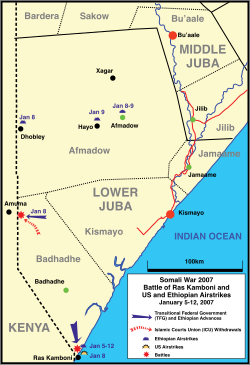| Battle of Ras Kamboni | |||||||
|---|---|---|---|---|---|---|---|
| Part of the Somalia War (2006–2009) Operation Enduring Freedom - Horn of Africa | |||||||
 Battle of Ras Kamboni, US & Ethiopian Airstrikes | |||||||
| |||||||
| Belligerents | |||||||
|
|
| ||||||
| Commanders and leaders | |||||||
|
|
Sharif Sheik Ahmed | ||||||
| Strength | |||||||
| Unknown | 500-1000 | ||||||
| Casualties and losses | |||||||
| Around 60 dead, 100 wounded in airstrikes[2] | |||||||
The Battle of Ras Kamboni took place during the Ethiopian invasion of Somalia at the start of 2007. It began Ethiopian National Defence Force (ENDF) and Transitional Federal Government (TFG) militia backed by United States military air power launched an offensive on Ras Kamboni, a town near the Kenyan border which was the last major urban stronghold of the Islamic Courts Union (ICU) as it with withdrew deep into the south.
After withdrawing from Kismayo, much of the ICU's armed forces scattered into the scrublands of southern Somalia or withdrew to make a last stand at Ras Kamboni.[3] The ICU forces at Ras Kamboni dug large defensive trenches around the town.[4] The battle began on January 6, 2007, when Ethiopian and TFG forces launched their assault. On January 7, 2007, the United States publicly entered the conflict by launching airstrikes using AC-130 gunships and cruise missiles against what it claimed were Al Qaeda members operating within the ranks of the ICU. The town finally fell to the Ethiopian and TFG forces on January 12, 2007. Initially, the US claimed that it had successfully targeted Al-Qaeda, but after the attacks downgraded those killed to being 'associates with terrorists'.[5] American forces reportedly killed hundreds of Somali fighters and civilians in a 'killing zone' between the Kenyan border, the Indian Ocean and advancing US backed Ethiopian troops.[6]
International concern and controversy arose over civilian casualties in additional airstrikes around Ras Kamboni and in Afmadow province, and whether these were the result of U.S. actions or Ethiopian aircraft operating in the area.
- ^ Tisdall, Simon (2007-01-09). "Clash of agendas". The Guardian. London. Retrieved 2007-01-10.
- ^ "al-Qaida Chief in Somalia May Be Dead". London: Associated Press. 2007-01-10. Retrieved 2007-01-10. [dead link]
- ^ Rice, Xan (6 January 2007). "Islamist fighters dig in on the border as Somalis plan 'final assault'". The Guardian. ISSN 0261-3077. Retrieved 2024-08-19.
- ^ "Somali and Ethiopian soldiers prepare major assault on Islamists". Sudan Tribune. Associated Press. 2007-01-06. Retrieved 2024-08-19.
- ^ Collins, Greg (23 August 2007). "Incorporating Africa's Conflicts into the War on Terror". Peace Review. 19 (3): 397–406. doi:10.1080/10402650701524998. ISSN 1040-2659. S2CID 144596992.
- ^ Francis, David J. (2010-02-25). US Strategy in Africa: AFRICOM, Terrorism and Security Challenges. Routledge. p. 121. ISBN 978-1-136-99662-7.